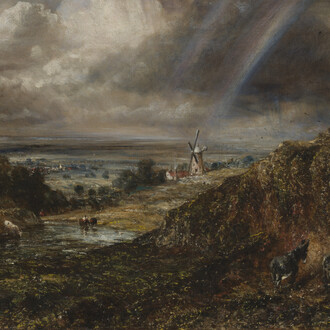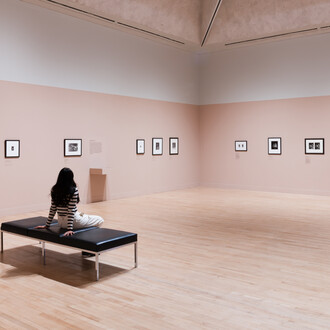Tate Britain unveils dock 2014, the largest and most ambitious work to date by sculptor Phyllida Barlow (b. 1944). The work has been created for the annual Tate Britain Commission 2014, supported by Sotheby’s. The commission invites artists to make new work in response to Tate’s collection of British and international art and to the grand spaces of the Duveen Galleries at the heart of Tate Britain.
Inspired by Tate Britain’s location beside the River Thames, dock 2014 is colossal in scale and physically intrusive. Visitors are encouraged to negotiate their own path through the work, looking up, down, across and around a network of components that hang from wooden structures or rest on the floor. dock is comprised of seven interrelated and individually named sculptures that fill the 100 metre-long Duveen Galleries and impede a natural passage through the galleries.
Phyllida Barlow has worked for over four decades with inexpensive, everyday materials to create large sculptural installations. dock is comprised of lightweight materials such as timber, metal, polystyrene, canvas, cardboard and rope. The materials and structures contrast with the smooth curves of the grand neoclassical architecture in which the work is installed.
The first part of dock, untitled: dock 5hungblocks, is made of five rectangular forms suspended on wooden frames that take inspiration from the shipping containers that are carried by boat along the river past Tate Britain. Next to the grand stone pillars of the Duveen Galleries stands untitled: dock: crushedtower, a functionless wooden tower and a pastiche of the monumental sculptures that Barlow’s work often reacts to. In the Octagon, the nine-metre high timber-framed untitled: dock: emptystaircasehoarding rises up to the gallery cornice forming an unruly barrier. Untitled: dock: 5stockadecrates comprises a series of timber frames of various heights loaded with piles of debris brought into the gallery from the artist’s studio.
Phyllida Barlow said: ‘In my response to the Tate Britain Commission, I was conscious of the architecture of the building, and how the outside appearance of the gallery seems to defy the scale on the inside. I wanted to explore two contradictory aspects: the enclosed gallery interiors against the ever-present aspect of the river beyond. dock brings in elements of both of these environments and also speaks to the heritage of the Duveens as a sculpture gallery.’
Penelope Curtis, Director, Tate Britain, said: ‘When we invited Phyllida Barlow to make work for the Tate Britain Commission we knew it would be exciting and challenging. dock 2014 has exceeded our expectations. The scale and energy of Barlow’s work is immense and it is wonderful to know that the work stems from a deep love and familiarity with Tate’s sculpture collection.’
Cheyenne Westphal, Co-Head of Contemporary Art Worldwide, said: ‘Every year, the Tate Britain Commission provides an enormously important platform for British artists, bringing them into the global spotlight and allowing for a celebration of today’s extraordinarily vibrant British art scene. We have already provided support for this important commission for six years and are now thrilled to be able to announce our continued commitment to the commission for the next three years.’
Phyllida Barlow (b. 1944) studied at Chelsea School of Art, London (1960-63) and then the Slade School of Fine Art, London (1963-66) where she later became a Professor. Recent international major exhibitions include Venice Biennale (2013), Carnegie International, Carnegie Museum of Art, Pittsburgh (2013), Des Moines Art Centre, Des Moines (2013), Norton Museum of Art, West Palm Beach (2013), New Museum, New York (2012), Ludwig Forum Aachen, Germany (2012), Kunstverein Nurnberg, Germany (2011), BAWAG Contemporary Vienna, Austria (2010), and Baltic Centre for Contemporary Art (2004). She became a Royal Academician in 2011 and lives and works in London.
All images Phyllida Barlow, dock 2014, Installation views: Tate Britain 2014, J Fernandes, Tate Photography.
















